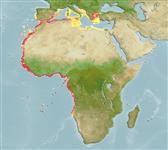Élasmobranches (requins et raies) (sharks and rays) >
Squatiniformes (Angel sharks) >
Squatinidae (Angel sharks)
Etymology: Squatina: Latin for skate, which angel sharks superficially resemble, presumably tautonymous with Squalus squatina Linnaeus 1758 (no species mentioned). (See ETYFish); aculeata: Latin for sharp-pointed, referring to large thorns on head and along back. (See ETYFish).
More on author: Cuvier.
Environment: milieu / climate zone / depth range / distribution range
Écologie
marin démersal; profondeur 30 - 500 m (Ref. 247). Subtropical; 43°N - 19°S, 18°W - 30°E
Eastern Atlantic: western Mediterranean, Morocco, Senegal, Guinea to Nigeria, Gabon to Angola.
Length at first maturity / Taille / Poids / Âge
Maturity: Lm ?, range 124 - ? cm
Max length : 188 cm TL mâle / non sexé; (Ref. 247); common length : 100.0 cm TL mâle / non sexé; (Ref. 26999); poids max. publié: 40.0 kg (Ref. 128028)
Found mainly on muddy bottom (Ref. 26999). Feeds on small sharks and jacks. Ovoviviparous (Ref. 50449). Utilized dried salted and fresh for human consumption; liver oil and hide also utilized (Ref. 247).
Life cycle and mating behavior
Maturité | Reproduction | Frai | Œufs | Fécondité | Larves
Ovoviviparous, embryos feed solely on yolk (Ref. 50449).
Compagno, L.J.V., 1984. FAO Species Catalogue. Vol. 4. Sharks of the world. An annotated and illustrated catalogue of shark species known to date. Part 1 - Hexanchiformes to Lamniformes. FAO Fish. Synop. 125(4/1):1-249. Rome, FAO. (Ref. 247)
Statut dans la liste rouge de l'IUCN (Ref. 130435)
Menace pour l'homme
Harmless
Utilisations par l'homme
Pêcheries: intérêt commercial mineur
Plus d'informations
Taille/ÂgeCroissanceLongueur-poidsLongueur-longueurFréquences de longueursMorphométrieMorphologieLarvesDynamique des populations larvairesRecrutementAbondanceBRUVS
RéférencesAquacultureProfil d'aquacultureSouchesGénétiqueElectrophoresesHéritabilitéPathologiesTraitementNutrientsMass conversion
CollaborateursImagesStamps, Coins Misc.SonsCiguateraVitesseType de nageSurface branchialeOtolithesCerveauxVision
Outils
Articles particuliers
Télécharger en XML
Sources Internet
Estimates based on models
Preferred temperature (Ref.
123201): 13.1 - 17.2, mean 15.2 °C (based on 65 cells).
Phylogenetic diversity index (Ref.
82804): PD
50 = 0.5000 [Uniqueness, from 0.5 = low to 2.0 = high].
Bayesian length-weight: a=0.00676 (0.00293 - 0.01558), b=3.07 (2.88 - 3.26), in cm total length, based on LWR estimates for this Genus-body shape (Ref.
93245).
Niveau trophique (Ref.
69278): 4.0 ±0.4 se; based on diet studies.
Résilience (Ref.
120179): Faible, temps minimum de doublement de population : 4,5 à 14 années (Fec assumed to be <100).
Fishing Vulnerability (Ref.
59153): Very high vulnerability (90 of 100).
Nutrients (Ref.
124155): Calcium = 13.9 [3.0, 67.9] mg/100g; Iron = 0.738 [0.191, 2.174] mg/100g; Protein = 19.7 [17.7, 21.7] %; Omega3 = 0.371 [0.168, 0.804] g/100g; Selenium = 33.5 [9.7, 99.1] μg/100g; VitaminA = 9.1 [3.3, 26.2] μg/100g; Zinc = 0.41 [0.20, 0.74] mg/100g (wet weight);
